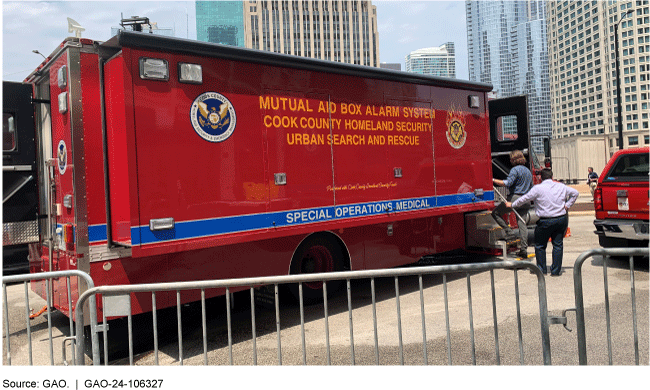Homeland Security Grants: DHS Implemented National Priority Areas but Could Better Document and Communicate Changes
Fast Facts
The Department of Homeland Security provides funds to help state and local governments prepare for terrorist threats. The Homeland Security Grant Program requires grantees to spend 30% of their funds on "National Priority Areas"—designated threat categories like cybersecurity. Almost all the areas have minimum spending requirements.
To respond to emergent risks, DHS has changed these priorities over time—e.g., adding an election security area in FY 2022. But some grantees said it was hard to meet requirements because they didn't get enough information from DHS about the changes.
We recommended that DHS improve documentation and outreach.
A terrorism task force vehicle funded by DHS grants in Chicago

Highlights
What GAO Found
The Department of Homeland Security's (DHS) Federal Emergency Management Agency (FEMA) established a process for making changes to its Homeland Security Grant Program National Priority Areas. However, it has not fully documented the rationale and process used for making the changes. Doing so could help DHS improve transparency for how or why these decisions are made and ensure continuity of institutional knowledge about the program.
FEMA has hosted webinars and technical assistance calls to provide grantees information on grant applications. But FEMA has not conducted additional targeted outreach, such as the listening sessions it conducted in fiscal year 2021 to solicit suggestions to improve its communication with stakeholders. Doing so would help FEMA better understand and address communication and other challenges stakeholders reported facing with implementing National Priority Area changes. This could also help FEMA better assist grantees with their planning efforts and help allow for the better prioritization of program funds moving forward.
Homeland Security Grant Program Funded Bomb Squad Vehicle

Source: GAO observation of Homeland Security Grant Program funded bomb squat vehicle at the 2023 National Homeland Security Conference. | GAO-24-106327
FEMA uses a variety of methods to monitor grantees' projects to ensure they align with National Priority areas. GAO found that grant projects from fiscal year 2020 through 2022 generally aligned with these areas. GAO also found that grantee projects changed over time to reflect associated changes to the National Priority Areas. For example, DHS added domestic violent extremism as a National Priority Area in fiscal year 2021. GAO's analysis of FEMA data found that grantees met required spending thresholds for this area and implemented associated projects.
Why GAO Did This Study
Since fiscal year 2002, FEMA has awarded over $55 billion in threat preparedness grants to state, local, tribal, and territorial governments. One of these grants is the Homeland Security Grant Program. In fiscal year 2020, DHS introduced National Priority Areas to this grant to target funding toward evolving threats. FEMA's process for changing the National Priority Areas consists of soliciting and analyzing information from various sources. FEMA provides potential recommendations to the Secretary of Homeland Security who makes the changes.
GAO was asked to examine how DHS established and makes changes to National Priority Areas. This report examines the extent to which: (1) DHS documented its process for changing the National Priority Areas and communicated changes to stakeholders; and (2) FEMA monitored grantee projects' alignment with the Priority Areas. GAO evaluated agency guidance and fiscal year 2020 through 2022 program data—the most current available—and interviewed FEMA officials. GAO interviewed state and local emergency management officials from 16 grantee jurisdictions selected to reflect a range of funding level and geography.
Recommendations
GAO is recommending that (1) DHS fully document the rationale and process for making changes to the National Priority Areas; and (2) FEMA conduct targeted outreach to stakeholders. DHS and FEMA concurred with our recommendations.
Recommendations for Executive Action
| Agency Affected | Recommendation | Status |
|---|---|---|
| Department of Homeland Security | The Secretary of Homeland Security should fully document the rationale and process DHS uses for making changes to the National Priority Areas, including identifying the stakeholders it consulted, and the information it used for making the changes. (Recommendation 1). |
When we confirm what actions the agency has taken in response to this recommendation, we will provide updated information.
|
| Federal Emergency Management Agency | The FEMA Administrator should conduct targeted outreach to stakeholders to better understand and address communication and other stakeholder challenges with implementing National Priority Area changes. (Recommendation 2). |
When we confirm what actions the agency has taken in response to this recommendation, we will provide updated information.
|
